heater GMC JIMMY 1997 Owner's Manual
[x] Cancel search | Manufacturer: GMC, Model Year: 1997, Model line: JIMMY, Model: GMC JIMMY 1997Pages: 410, PDF Size: 20.03 MB
Page 62 of 410
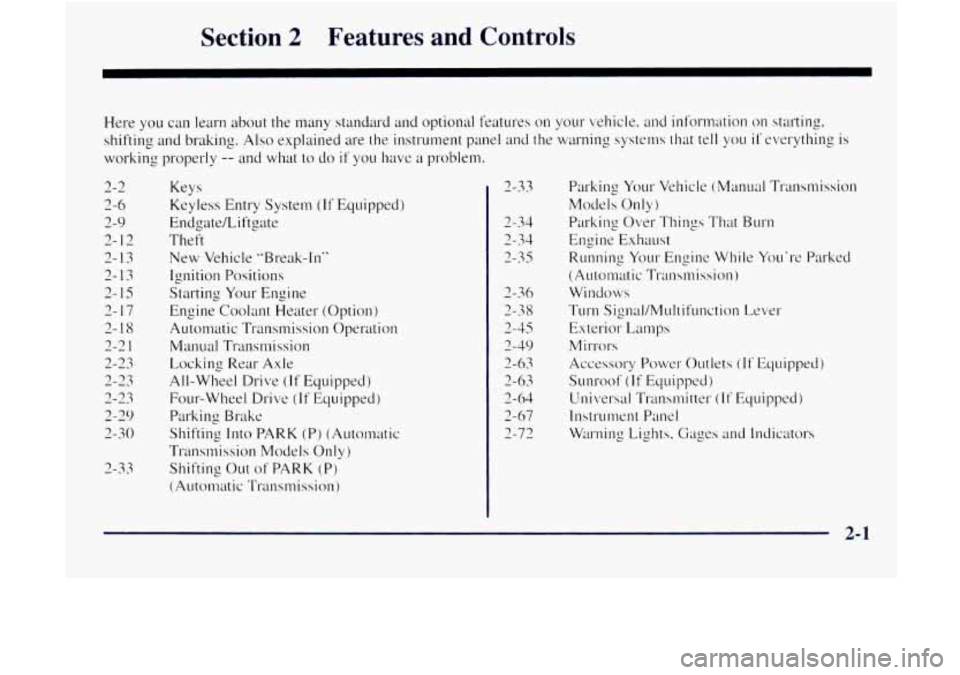
Section 2 Features and Controls
Here you can learn about the many standard and optional features on your vehicle. and information on starting.
shifting
and braking. Also explained are the instru~nsnt panel and the warning systems that tell you if everything is
working properly
-- and what to do if you have LI problem.
2-2
2-6
2-9
2- 1 2
2-13
2-13
2- 15
2- 17
2-18
2-2 I
2-23
2-23
2-23
3-29
2-30
2-33
Keys
Keyless Entry System (If Equipped)
Endgate/Liftgate
The
t't
New Vehicle "Break-In"
Ignition Positions
Starting Your Engine
Ensine Coolant Heater- (Option)
Automatic Transmission Operation
Manual Transmission
Locking Rear Axle
All-Wheel Drive
(If Equipped)
Four-Wheel Drive (If Equipped)
Parking Brake
Shifting
Into PARK (P) (Automatic
Trans~nission Models
Only)
Shifting Out of PARK (Pj
(Automatic Transmission) 2-33
3-34 -
2-33
2-.3S
2-36
- 7-38
3-45
2-41)
2-63
2-63
2-64
2-67 2-72
2-1
Page 78 of 410
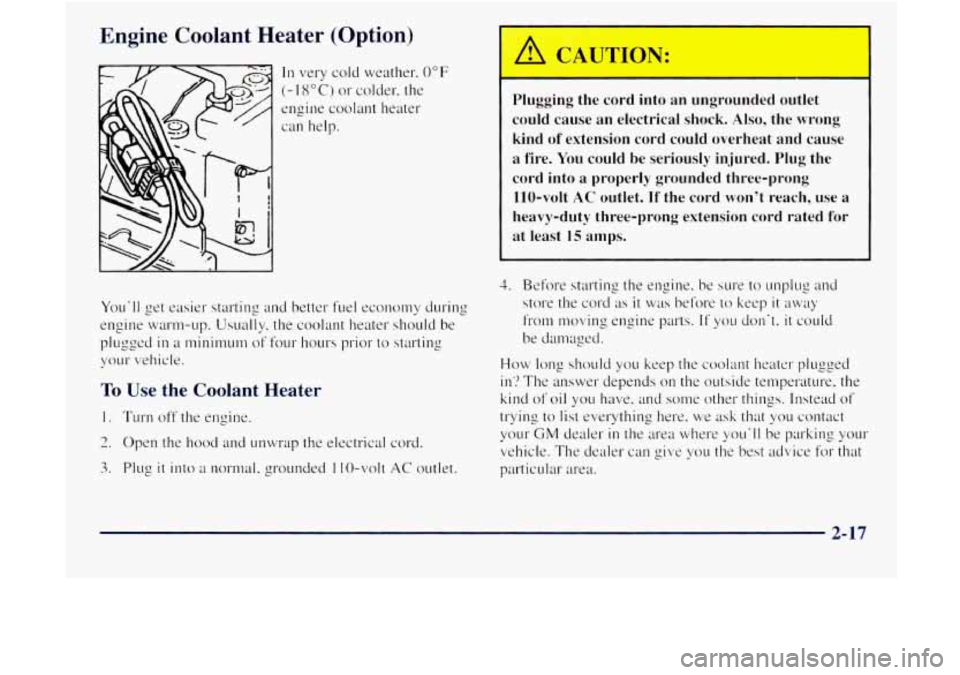
Engine Coolant Heater (Option)
In very cold weather. 0°F
(- 18°C) or colcfer. the
engine coolant heater
can help. Plugging the cord into an ungrounded outlet
could cause an electrical shock. Also, the wrong
kind
of extension cord could overheat and cause
a fire. You could be seriously injured. Plug the
cord into
a properly grounded three-prong
110-volt
AC outlet. If the cord won't reach, use
heavy-duty three-prong extension cord rated for
at least
15 amps.
You'll get easier starting and better file1 economy during
engine wa1-tm-up. Usually, the coolant heater should be
plugged
in a tnini~num of four hours prior to starting
your vehicle.
To Use the Coolant Heater
1. Turn off the engine.
2. Open the hood and unwrap the electrical cord.
3. Pl~lg it into a nol-r.nal, grounded 1 IO-volt AC outlet.
4. Before starting the engine. be s~11-e to unplug and
store the cord as it was before to keep it away
from moving engine parts. If you clon't. it could
be da111~1ged.
How long should you keep the coolant heater plugged
in? The answer depends on the outside temperature. the
kind
of oil you have, and solne other things. Instead of
trying to list everything here. we ask that ~OLI contact
yoc~r
GM dealer in the area where you'll be parking your
vehicle. The dealer can gi\:e you the best advice for that
particular area.
2-17
Page 146 of 410
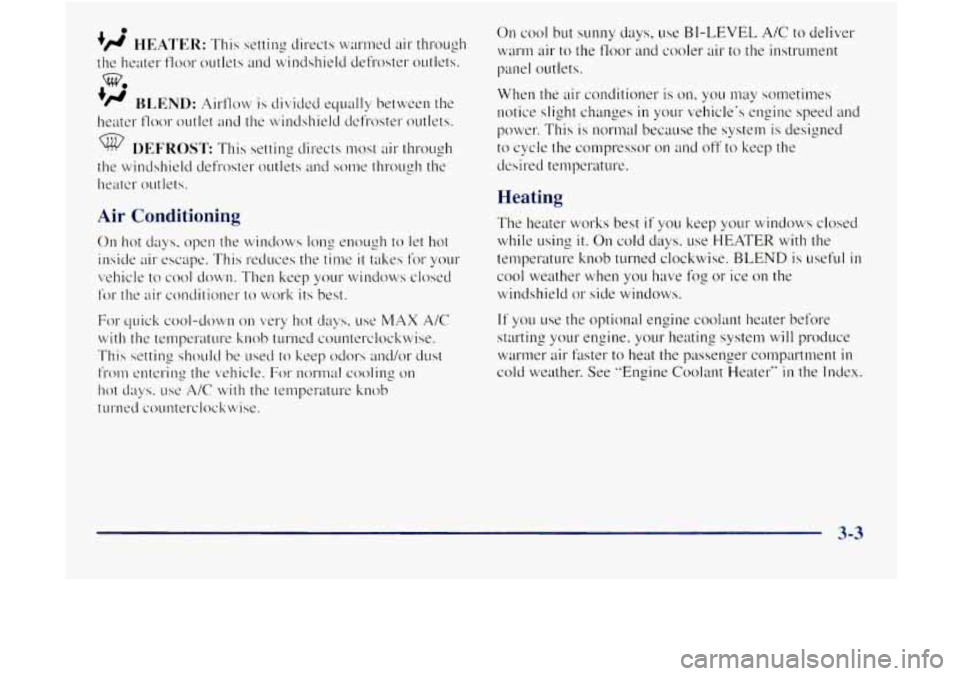
Air Conditioning
011 cool but sunny days, use BI-LEVEL A/C to deliver
~varm
air to the floor and cooler air to the instrument
p"nel outlets.
When the air conditioner is on. you may sometimes
notice slight changes
in your 1:ehicle's engine speed and
power, This
is normal because the system is designed
to cycle the compressor
on and off to keep the
clesired temperature.
Heating
The heater works best if yo11 keep plr windows closed
while using
it. On cold days. use HEATER With the
ten~perature knob turned clockwise.
BLEND is LISS~LI~ in
cool weather when you have fos or ice on the
winclshield
or side windows.
If ~OLI use the optional engine coolant heater befhre
starting yo~~r engine. your heatin2 system will produce
warmer air faster to heat the passenger compartment
in
cold weather. See "Engine Coolant Heater" in the Index.
3-3
Page 147 of 410
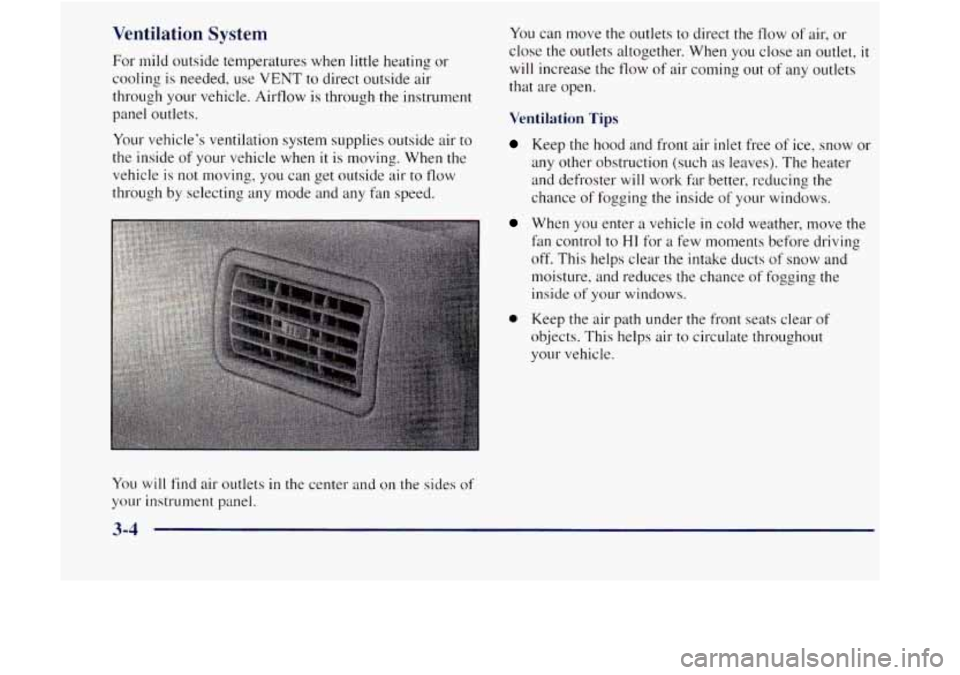
Ventilation System
For mild outside temperatures when little heating or
cooling
is needed, use VENT to direct outside air
through your vehicle. Airflow
is through the instrument
panel outlets.
Your vehicle’s ventilation system
supplies outside air to
the inside of your vehicle when
it is moving. When the
vehicle is not moving, you can get outside air
to flow
through by selecting any mode and any fan speed. You
can move
the outlets to direct the flow of air, or
close the outlets altogether. When you close
an outlet, it
will increase the tlow of air coming out of any outlets
that are open.
Ventilation Tips
Keep the hood and front air inlet free of ice, snow or
any other obstruction (such as leaves). The heater
and defroster
will work far better, reducing the
chance
of fogging the inside of your windows.
When you enter a vehicle in cold weather, move the
fan control
to HI for 2.1 few moments before driving
off. This helps clear the intake ducts of snow and
moisture, and reduces the chance of fogging the
inside of your windows.
0 Keep the air path under the front seats clear of
objects. This helps air to circulate throughout
your vehicle.
You will find air outlets in the center and on the sides of
your instrument panel.
Page 205 of 410

Snow can trap exhaust gases under your vehicle.
This can cause deadly
CO (carbon monoxide) gas
to get inside.
CO could overcome you and kill
you. You can’t see it or smell it,
so you might not
know it is in your vehicle. Clear away snow from
around the base of your vehicle, especially any
that is blocking your exhaust pipe. And check
around again from time to time to be sure snow
doesn’t collect there.
Open a window just a little on the side of the
vehicle that’s away from the wind. This will help
keep
CO out.
Run your engine only as long as you must. This saves
fuel. When
you run the engine, make it go a little faster
than just idle. That is, push the accelerator slightly.
This
uses less fuel for the heat that you get and it keeps the
battery charged.
You will need a well-charged battery to
restart the vehicle. and possibly for signaling later on
with your headlamps. Let the heater run for a while.
Then, shut the engine
off and close the window almost
all the way
to preserve the heat. Start the engine again
and repeat this only when you feel really uncomfortable
from the cold.
But do it as little as possible. Preserve the
fuel as long
as you can. To help keep warm, you can get
out of the vehicle and
do some hirly vigorous exercises
every half
hour or so until help comes.
4-40
Page 234 of 410

If No Steam Is Coming From Your Engine
If you zet the overheat warning but see or hear no
steam. the problem may not be too serious. Sometimes
the engine can get
a little too hot when you:
0 Climb a long hill on a hot day.
Stop after high-speed driving.
Idle for long periods in traffic.
Tow a trailer. See "Driving on Grades" in the Index.
If you get the overheat warning with no sign of steam,
try this for a minute
or so:
2. T~11-11 on yo~~r heater to full hot at the highest fan
speed and open the window as necessary.
3. If you're in a traffic jam. shift to NEUTRAL (N):
otherwise, shift to the highest gear \vhile
driving -- AUTOMATIC OVERDRIVE ((33) or
DRIVE (D) for automatic transmissions.
If you no longer have the overheat warning. you
can drive. Just
to be safe. drive slower for about
10 minutes. If the warning doesn't come back on.
you can drive norrnally.
If the warning continues. pull over, stop, and park your
vehicle right away.
If there's still no sign of steam. push the accelerator until
the engine speed is about twice as fast as normal idle
speed. Bring the engine speed back
to normal idle speed
after two or three minutes. Now see
if the warning stops.
But then, if you still have the warning, rum ogtlw
eugine
c~l got el?er;\.olw out oftlw \vl~iclc. until it
cools down.
You
may decide not to lift the hood but to get service
help right
away.
5-13
Page 236 of 410

Heater and radiator hoses, and other engine
parts, can be very hot. Don't touch them.
If' you
do, you can be burned.
Don't run the engine
if there is a leak. If' you run
the engine, it could lose all coolant. That
could
cause an engine fire, and you could be burned.
Get any leak fixed before
you drive the vehicle.
I NOTICE:
Engine damage from running your engine
without coolant isn't
covered by your warranty.
If there seems to be 110 leak, start the engine again. See
if the t'an speed increases when idle speed is doubled by
pushing the accelerator pedal
down. If it doesn't. your
vehicle needs service. T~1l-11
off the engine.
Page 237 of 410
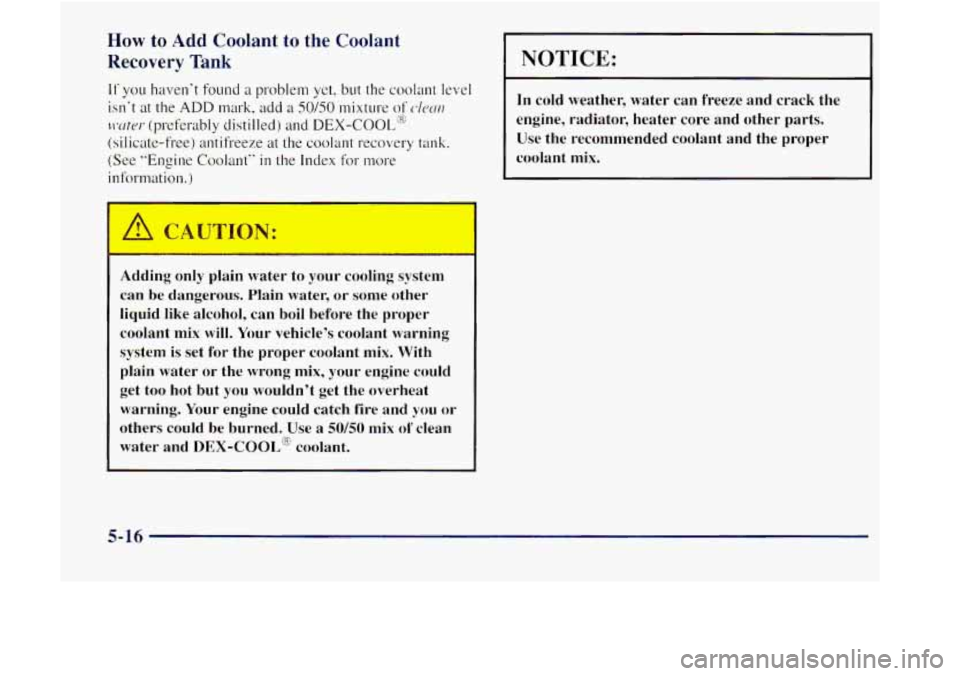
How to Add Coolant to the Coolant
Recovery Tank
If you haven't found a problem yet, but the coolant level
isn't at the
ADD mark, add a SO/SO mixture of d~ctrz
,twtur (preferably distilled) and DEX-COOL'@
(silicate-free) antifreeze at the coolant recovery tank.
(See "Engine Coolant" in the Index for more
information.
)
_s I
Adding only plain water to your cooling system
can be dangerous. Plain water, or some other
liquid like alcohol, can boil before the proper
coolant mix
will. Your vehicle's coolant warning
system is set for the proper coolant mix. With
plain water or the wrong mix, your engine could
get too hot but you wouldn't get the overheat
warning. Your engine could catch fire and you or
others could be burned. Use
a 50/50 mix of clean
water and
DEX-COOL" coolant.
NOTICE:
In cold weather, water can freeze and crack the
engine, radiator, heater core and other parts. Use the recommended coolant and the proper
coolant mix.
5-16
Page 282 of 410
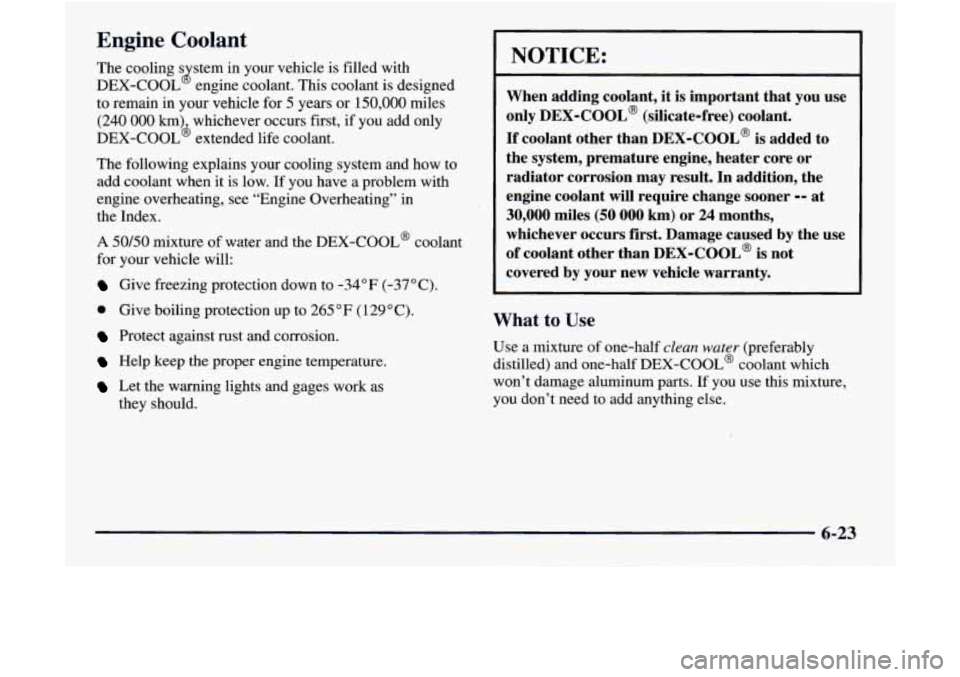
Engine Coolant
The cooling s stem in your vehicle is filled with
DEX-COOL engine coolant. This coolant is designed
to remain in your vehicle
for 5 years or 150,000 miles
(240 000 km) whichever occurs first, if you add only
DEX-COOL’ extended life coolant.
The following explains your cooling system and how to
add coolant when it is low. If you have a problem with
engine overheating, see “Engine Overheating” in
the Index.
A 50/50 mixture of water and the DEX-COOL@ coolant
for your vehicle will:
Give freezing protection down to -34°F (-37°C).
0 Give boiling protection up to 265 OF ( 129 O C).
Protect against rust and corrosion.
Help keep the proper engine temperature.
Let the warning lights and gages work as
8
they should.
NOTICE:
When .adding coolant, it is important that you use
only
DEX-COOL@ (silicate-free) coolant.
If coolant other than DEX-COOL@ is added to
the system, premature engine, heater core
or
radiator corrosion may result. In addition, the
engine coolant will require change sooner
-- at
30,000 miles (50 000 km) or 24 months,
whichever occurs
first. Damage caused by the use
of coolant other than DEX-COOL@ is not
covered by your new vehicle warranty.
What to Use
Use a mixture of one-half clean water (preferably
distilled) and one-half DEX-COOL@ coolant which
won’t damage aluminum parts. If you use this mixture,
you don’t need to add anything else.
6-23
Page 283 of 410
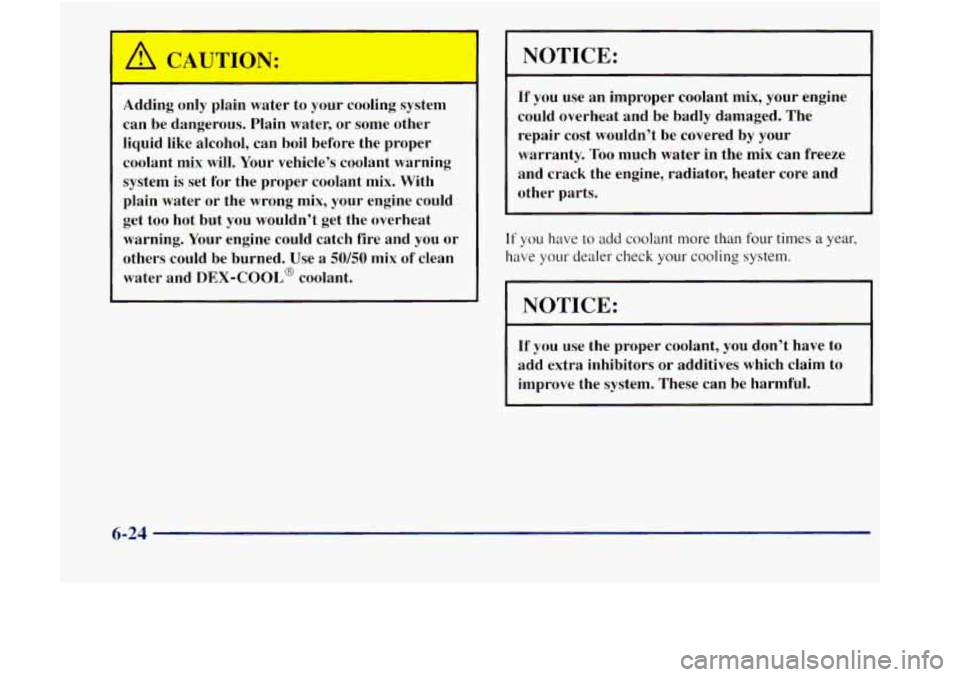
Adding only plain water to your cooling system can be dangerous. Plain water, or some other
liquid like alcohol, can boil before the proper
coolant mix will. Your vehicle’s coolant warning
system
is set for the proper coolant mix. With
plain water or the wrong mix, your engine could
get too hot but you wouldn’t get the overheat warning. Your engine could catch fire and you or
others could be burned. Use a
50/50 mix of clean
water and
DEX-COOL@ coolant.
NOTICE:
If you use an improper coolant mix, your engine
could overheat and be badly damaged. The
repair cost wouldn’t be covered by your
warranty.
Too much water in the mix can freeze
and crack the engine, radiator, heater core and
other parts.
If you have to add coolant more than four times a year,
have your dealer check your cooling
system.
I NOTICE:
If you use the proper coolant, you don’t have to
add extra inhibitors or additives which claim to improve the system. These can be harmful.
6-24